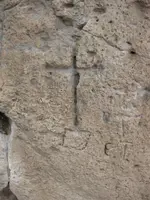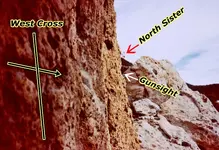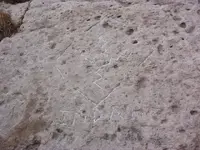Unreconciled Pinos Altos gold legends
4. Spanish mines on Twin Sisters Peaks
There are a number of legends indicating Spanish gold mines in the Pinos Altos/Santa Rita del Cobre mineralized zone. Historians date Spanish activity in the area to ca 1800, when Carrasco, Elguea and others began shipping native copper and other very high quality oxide ores to the Royal Mint in Chihuahua for coinage. However, military reports indicate regular patrolling of the area in the mid-1700s from the presidio at Janos, trying to control Apaches who were constantly terrorizing the miners. In the earlier days of the famous copper mine, very high gold values were also recovered from the oxide ores, and there are a separate set of lost mine/cache legends as a result - one of the most believable surfaced about fifteen years ago. For the purpose of this Lost Adams discussion, however, we will focus on
Spanish mines on Twin Sisters Peaks - aka “dos piloncillos.”
In the 1980s, a group known as Codebreaker Enterprises Inc. cleared a concealed and collapsed vertical shaft collar at a very old mine high on the east face of the
north Twin Sister (TS1) and explored the workings inside. They recovered and privately displayed several artifacts that were arbitrarily dated to roughly the 1750-1800 era, the most impressive find being a “Spanish firearm”. This secretive organization revealed nothing more about what was found in the old mine, and then decided to collapse the collar again and reseal the entrance. Some years later, my exploration partner and I discovered a second, lower tunnel that presumably connected to the same workings, but we chose not to attempt an entry due to what we considered a severe safety risk. The opening - more like a gopher hole - was very small, in unstable ground with no support, and evidence of wall- and ceiling-collapse not far inside.
View attachment 1179743 View attachment 1179744
Collapsed collar TS1 ..................................................Lower TS1 connecting tunnel
The sealed upper shaft of
TS1 was allegedly located using a very weathered rock carving about a thousand feet away from the opening. The carving is a Christian cross on a pedestal, its right cross arm ending with an arrow pointing through a notch in the nearby rock directly to the mine.
View attachment 1179745 View attachment 1179746
Carved west cross ........................................TS1 mine pointer
Codebreaker Enterprises Inc. opened a second backfilled mine shaft on the
north Twin Sister (TS2), also high on the mountain, this time an inclined shaft on the northwest face. Much backfill was removed in the 1990s. Nothing was said about what was found inside. I have no photos of the site, which was also later backfilled and abandoned, but reopened ca mid-2000s. No reports have been given on the second reopening.
A third backfilled mine opening
(TS3) is located on the south face of the
north Twin Sister, lower than the other two sites. It appears from the surface as if it is a horizontal opening, with its backfill significantly eroded. The tunnel has not been reopened to my knowledge.
View attachment 1179747
TS3
The
south Twin Sister has only one apparent old mine
(TS4) visible on the mountain - a twenty-foot diameter pit about eight feet deep near the top of the mountain. No modern era work appears to have been done on this site. Codebreaker Enterprises Inc. possessed mining claims for only the three mines on the north Twin Sister for years. I don’t know if those claims are still current. My research indicates that neither the three mines on the north Twin Sister nor the one on the south had any prior mining locations filed in the Grant County Mining Location records. Presumably they were located and worked prior to the Anglo period.
There is solid evidence that three or four previously-worked and closed mine workings exist on
Twin Sisters Peaks, and that circumstantial evidence provides a reasonable possibility that the sites likely date to a time before the Anglo era in the Pinos Altos vicinity (ca 1860) - perhaps a hundred years earlier, perhaps more. Could one or more of these old mines be the site that the Apaches warned the Adams party to stay away from in 1863, when the group was placer mining below in Bear Creek? We can’t know with the information that we have so far.
There are many rock carvings on Twin Sisters Peaks - some obviously modern graffiti from hikers, but many old and enigmatic. One of the latter is especially puzzling. The carving is very weathered and hard to find unless you know where to look. Below is a photo of it. It was necessary to chalk the lines in order for the faint message - whatever it means - to be visible. The word is “INDAH”. The style seems modern - likely not earlier than the late-19th century. The word in the Apache language means, “white people”. It’s unknown who carved it, when or why.
View attachment 1179752
INDAH

















